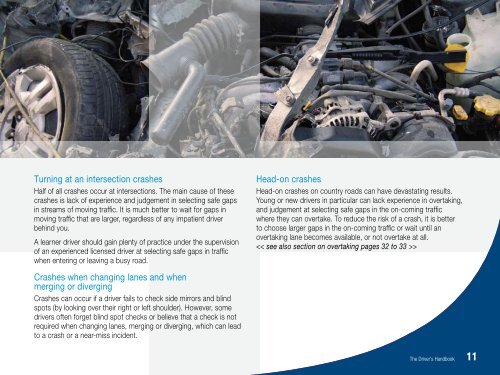the driver's handbook
the driver's handbook
the driver's handbook
- TAGS
- handbook
- 210.247.132.180
Create successful ePaper yourself
Turn your PDF publications into a flip-book with our unique Google optimized e-Paper software.
Turning at an intersection crashes<br />
Half of all crashes occur at intersections. The main cause of <strong>the</strong>se<br />
crashes is lack of experience and judgement in selecting safe gaps<br />
in streams of moving traffic. It is much better to wait for gaps in<br />
moving traffic that are larger, regardless of any impatient driver<br />
behind you.<br />
A learner driver should gain plenty of practice under <strong>the</strong> supervision<br />
of an experienced licensed driver at selecting safe gaps in traffic<br />
when entering or leaving a busy road.<br />
Crashes when changing lanes and when<br />
merging or diverging<br />
Crashes can occur if a driver fails to check side mirrors and blind<br />
spots (by looking over <strong>the</strong>ir right or left shoulder). However, some<br />
drivers often forget blind spot checks or believe that a check is not<br />
required when changing lanes, merging or diverging, which can lead<br />
to a crash or a near-miss incident.<br />
Head-on crashes<br />
Head-on crashes on country roads can have devastating results.<br />
Young or new drivers in particular can lack experience in overtaking,<br />
and judgement at selecting safe gaps in <strong>the</strong> on-coming traffic<br />
where <strong>the</strong>y can overtake. To reduce <strong>the</strong> risk of a crash, it is better<br />
to choose larger gaps in <strong>the</strong> on-coming traffic or wait until an<br />
overtaking lane becomes available, or not overtake at all.<br />
><br />
The Driver’s Handbook 11


